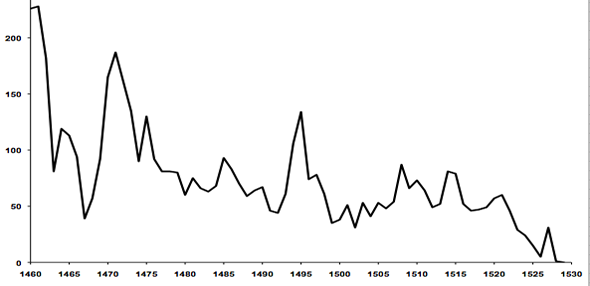Crisis years: 1494/1507 – 1523 – 1529
The first decades of the newly founded university were eventful, with enrollments fluctuating from year to year. There were intense disputes about the character and orientation of the institution, and securing funding remained a constant task. Nevertheless, the first generation was quite successful even compared to other universities founded during the same period. In the 1480s and early 1490s, however, the enrollments declined so significantly that the City Council, faced with political challenges, began to ask whether it should close the university.
In the mid-1490s, multiple council discussions were held on the state of the university, even considering its dissolution. At the same time, however, a certain humanistic reorientation took place: a lectureship in poetry was awarded to Sebastian Brandt, and the renowned jurist Ulrich Krafft, former student of canon law in Basel and rector of the University of Freiburg, was hired as a professor. These developments were bound up with an increase in enrollments – as well as a significant increase in expenditures.
Hence in 1501, the year Basel joined the Swiss Confederacy, it was explicitly resolved after lengthy deliberations “that the university should not be abandoned,” while a decision was also taken to once again pursue new benefices and restrict the privileges of university members. At the Swiss Diet in 1504, Basel accordingly made a new attempt to finally incorporate its benefices within the Swiss Confederacy and to assert itself as a kind of national university. Both initiatives failed.
Swiss students continued to attend German universities in increasing numbers at the beginning of the sixteenth century. The enrollment of German students in Basel, by contrast, decreased significantly as a result of the Swabian War of 1499, as well as Basel’s accession to the Swiss Confederacy.
The “benevolence”: incorporation of the benefices into the city’s budget
In this financially strained situation, the City Council responded to the unsatisfactory situation in 1507 by restructuring its financial relations with the university. During a phase of shrinking city budgets, it decided to provide 200 guilders annually as a “benevolence” to pay faculty salaries. In return, the revenues from the benefices – which had replaced the services previously rendered by their holders since 1504 – were integrated into the city’s budget. This significantly reduced the city’s net financial burden in support of the university, allowing it in each of the following years to cover about one-third of its expenses for the university through income from benefices. In exchange for the guarantee of a modest level of funding, the university’s members had to forgo their exemption from the city’s meat tax, losing another privilege they had been granted in the Letter of Freedoms, as they had also been paying the flour tax since 1474. This consolidation of the university’s finances and integration with the city budget led to a significant restriction of privileges for university members and was accompanied by an increasing regionalization of the university.
The dismissal of four opponents of the Reformation in 1523
From the outset, conflicts provoked by the Reformation extended to the university. Members of the university, for instance, participated in a demonstrative meal of roasted pig – in defiance of Catholic custom – during Lent in 1522, in Klybeck Castle, followed by an attempt to force the election of a new rector. The institution, however, was a conservative stronghold of opponents to the Reformation: one of its teachers, Bonifaz Wolfhart, had his teaching license revoked for breaking the Lenten fast, and the rector of the winter semester 1522/23 decorated his Entry in the matriculation book with a complaint about Luther the reformer.
The following year saw the first escalation. Four professors – Johannes Gebweiler, Mauricius Finninger, Johannes Mörnach, and Johannes Romanus Wonnecker – denounced two popular Reformist preachers, Lüthart and Konrad Pellikan, to the head of the Franciscan province during a visitation at Lent in 1523. When it emerged that the two were then to be transferred as punishment to another position, the City Council demanded that this decision be rescinded and withdrew the salaries of the four professors. The following June, the council then appointed Pellikan and Johannes Oekolampad, who later played a role in the Reformation in Basel, as professors of theology in their place. The university resisted this action, with the jurists pointedly reelecting Mörnach as dean four more times. The theologians refused to accept Oekolampad and Pellikan as members of the faculty, while its rectors without exception noted the “pestis animarum,” the plague of the soul and the discord of the times, in their entries in the matriculation books.
The university at the height of the Reformation turmoil
In the following years, the university increasingly split into two factions. Oekolampad in the Faculty of Theology, Oswald Baer in the Faculty of Medicine, and Torinus in the Faculty of Liberal Arts stood as supporters of the Reformation against the skeptics and so-called followers of the traditional faith, whose ranks included the theologian Ludwig Baer and the jurists Cantiuncula and Amerbach, as well as Sichart and Glarean, who had revised their pro-Reformation positions following the Peasants’ War.
Conflicts continued to escalate, and enrollment dropped drastically to just one student in December 1528, a certain Caspar Schüfelbiel from Münster in Aargau.
At the peak of the unrest in 1529, several professors and students, along with the cathedral chapter, left the city for Freiburg. However, contrary to the prevailing view in older research, it does not seem like the university entirely ceased operations. In 1531, for instance, during what is often called the interregnum, the first public anatomical dissection took place at the Faculty of Medicine under Oswald Baer, the last rector before the Reformation decisively took hold in 1529 and the first after the “reopening” of the university in 1532. This event marked the beginning of a long success story for anatomy in Basel.



